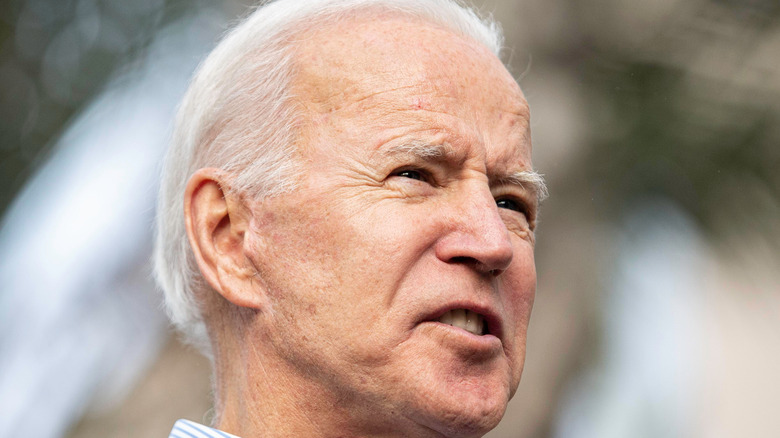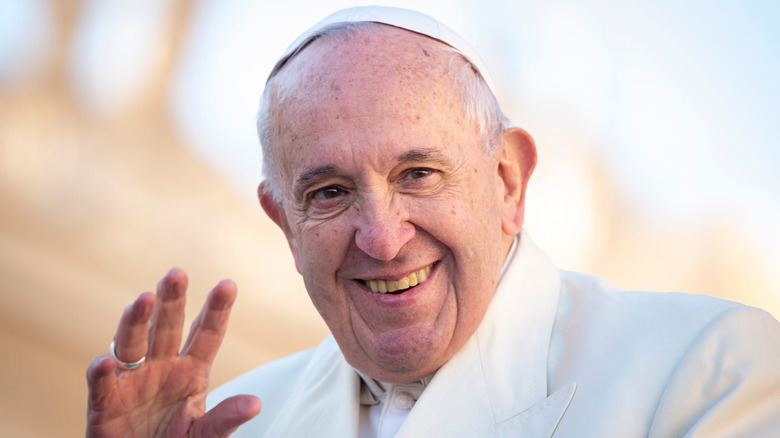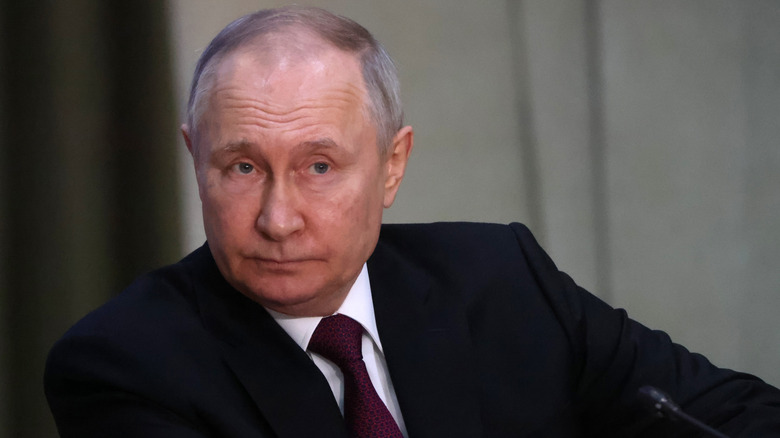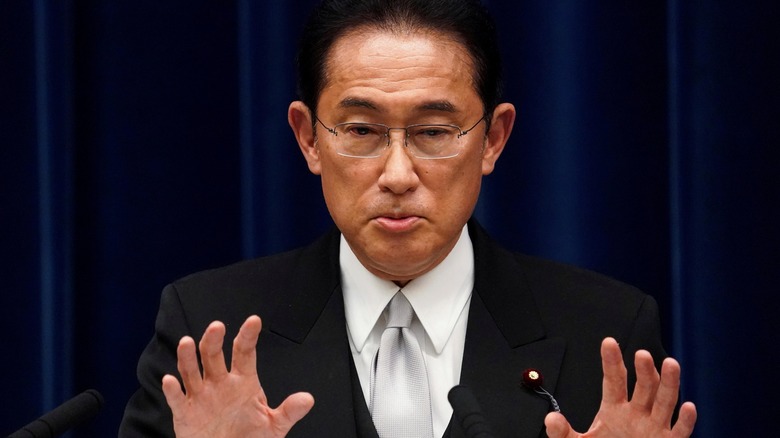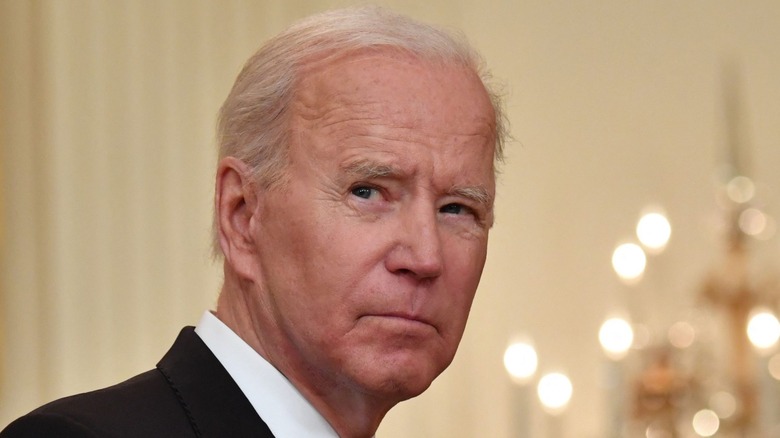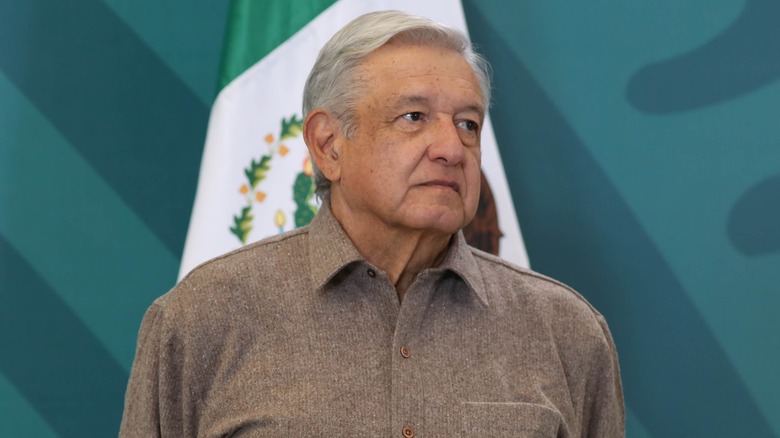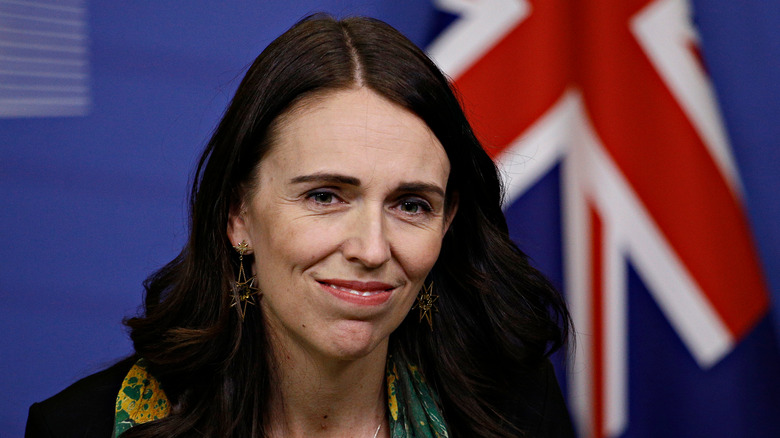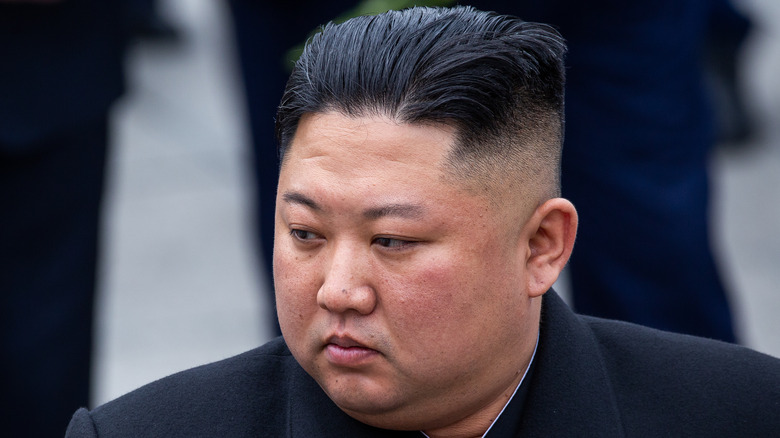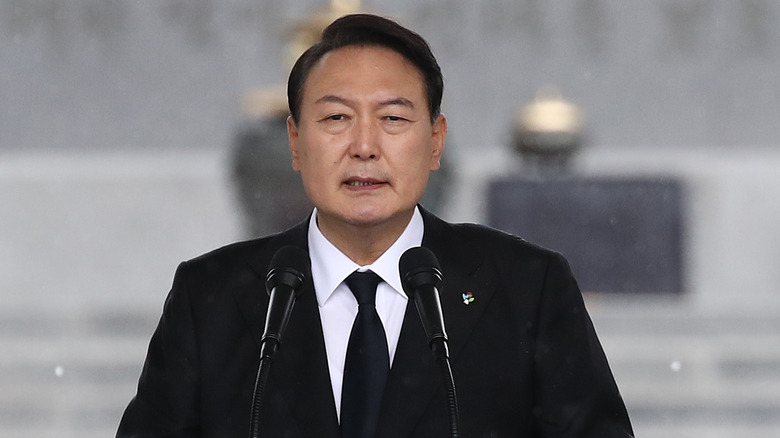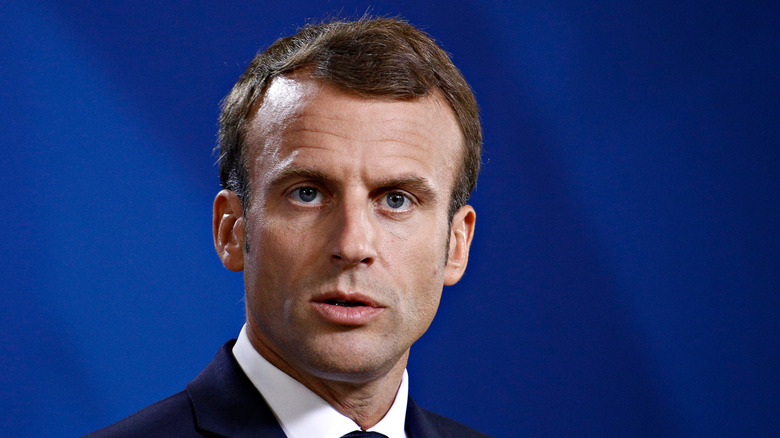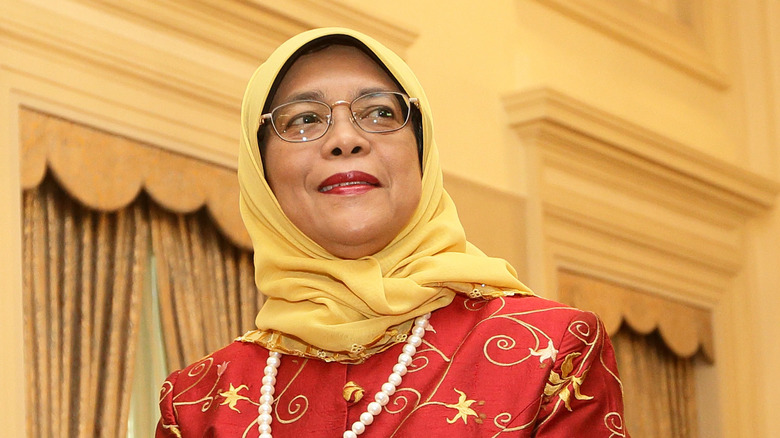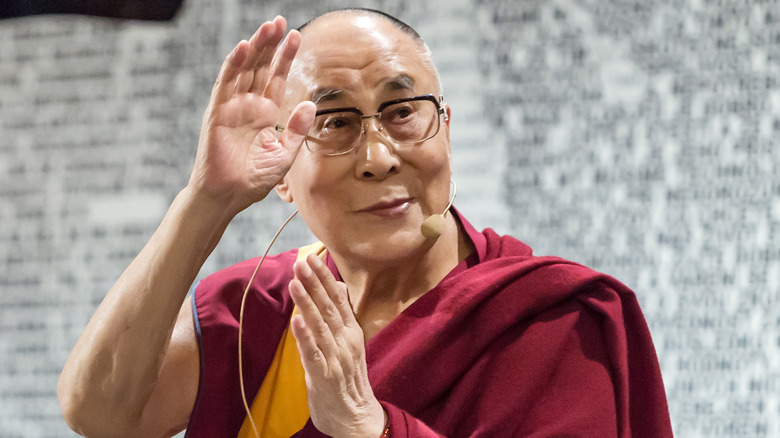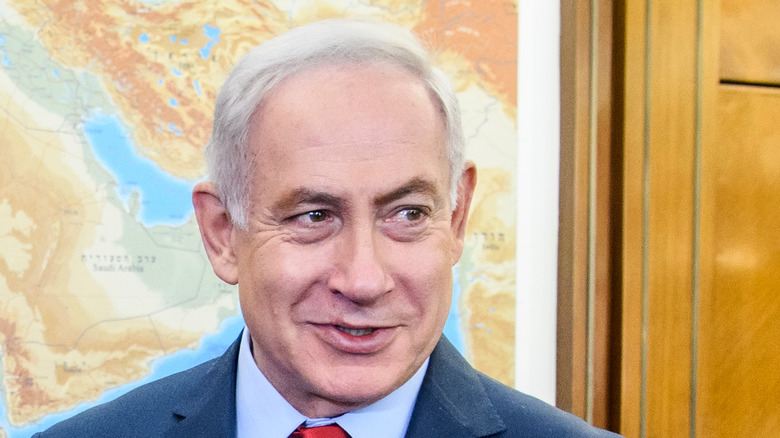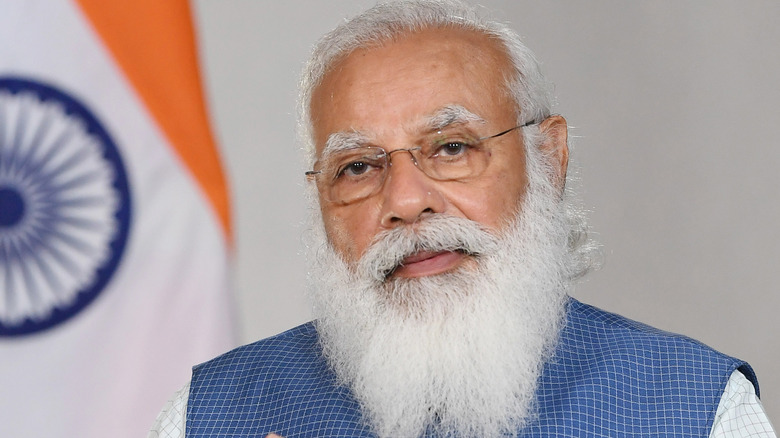13 Favorite Foods Of Leaders Around The World
We spend a lot of time analyzing politicians, and not just on politics. We wonder which designers they're wearing, where they went running, and even who their dog bit — but what about the favorite foods of leaders around the world? More than trying out a workout or copying a skincare routine, seeing which foods leaders reach for again and again is one of the best ways to understand them better.
Food preferences aren't just about what someone eats. They tell a story about where someone is from, what they prioritize, and potentially where their weaknesses lie. And perhaps more than anything, food preferences provide a glimpse into a more human version of people whose lives are so radically different from our own. Some of their favorites are obviously delicious, others are surprising, and most will make you shoot milk out your nose they're so funny. Check out this article to see a full rundown of the surprisingly relatable favorite dishes of these global leaders.
Pope Francis
Given how closely guarded he is, no one would blame you for thinking that the leader of the Catholic Church subsists on an austere diet of bread, fish, and vegetables. While it is true that Pope Francis mainly eats a simple diet composed of baked chicken, salad, fruit, and (some) wine, there's more to his diet than meets the eye. For one, he loves the food of his adopted home in Rome, in particular pasta and pizza. Unfortunately, he doesn't get to eat either one that often. Vatican doctors urged him to cut back on pasta for health reasons, and grabbing a slice of pizza at the local pizzeria when you're the pope? Not gonna happen.
Besides Italian staples, the Buenos Aires-born religious leader turns to comfort foods from his native land. Specifically, he enjoys meat, maté (a caffeine-rich herbal beverage), and alfajores, a dessert featuring dulce de leche sandwiched between two cookies.
Vladimir Putin
No list of world leaders' favorite foods would be complete without talking about how much Russia's president loves ice cream. Strange as it may seem, culinary writer Anya von Bremzen (herself born in the former USSR), claims that Soviets of Putin's generation love ice cream to the point of eating it throughout Russia's sub-zero winters. Putin is pretty tight-lipped about his life, but several reports mention pistachio as his favorite flavor. As further proof of Putin's affinity for frozen desserts, he was spotted treating Turkish President Recep Tayyip Erdogan to some ice cream bars during a 2019 state visit. The same year, he gave China's president Xi Jinping Russian ice cream as a birthday gift.
Although Putin's dessert preferences are well-known, his other culinary habits are closely-guarded secrets. What we do know is that he mostly avoids alcohol and sweets, and employs a food taster to check for poison.
Fumio Kishida
Japan's Prime Minister may not be particularly savvy when it comes to social media, but a picture of his election-night okonomiyaki dinner garnered well over 350,000 likes on Twitter. Along with a picture of the dish, Kishida tweeted "When I got home, my wife Yuko made me okonomiyaki, because I had said I love the dish ... It's always super delicious, but today it was so delicious I won't forget it for a lifetime."
Okonomiyaki is a compound word coming from okonomi, meaning what you like, and yaki, meaning grilled. True to its name, the savory pancake made primarily from cabbage and flour comes in all kinds of variations depending on where it's made. The Osaka version has a thick batter made out of cabbage, eggs, and pork. These ingredients are combined, then grilled. Once off the heat, the pancake is topped with a semi-sweet sauce, Kewpie mayonnaise, and bonito flakes. In Hiroshima, where Kishida is from, the batter is crepe-like. Rather than getting mixed together, the main ingredients are stacked on top of each other prior to grilling. This version also features yakisoba noodles, whereas the Osaka version does not. Another difference is the toppings. Hiroshima-style okonomiyaki is finished with a sweet sauce, an egg yoke, and a smattering of spring onions.
Joe Biden
Joe Biden's food preferences have been dissected meal by meal ever since he served as vice president. Although there are a lot of takeaways, one thing is clear — President Biden likes to keep things simple. Lunch is usually a soup and salad and dinner is pasta with marinara sauce. Even his pantry staples (ketchup, peanut butter, jelly, sliced cheese, and orange Gatorade) read more like a preschooler's shopping list than sustenance for the leader of the free world.
Of course, no food item is closer to the president's heart than ice cream. In a campaign speech, he even mentioned eating enough ice cream to satisfy three people. Biden feeds his chilly addiction by keeping a stash of his beloved vanilla chocolate chip Häagen-Dazs at The White House and stopping for creamy treats while on the road (though he recently gave it up for Lent). Columbus, Ohio-based Jeni's Splendid Ice Cream is his favorite spot, but pretty much any brand will do when he gets a craving.
Andrés Manuel López Obrador
Forget tacos and enchiladas — Mexico's president, Andrés Manuel López Obrador, goes for barbacoa. Without wanting to play favorites, Obrador named El Carnerito in Tulancingo, Hidalgo as, if not the best barbacoa restaurant in the country, then at least very close to the top. He backs up his statement in a video posted on his official Twitter account, claiming that he knows almost all of the barbacoa restaurants in the country.
Barbacoa was brought to Mexico by the Taíno, a group indigenous to Cuba, Jamaica, Hispaniola, and Puerto Rico. Traditionally, it was made by wrapping an entire sheep and an open fire pit with maguey leaves, a large type of agave. As the leaves cooked, they infused the fatty meat with a tequila-like flavor. Mexico's version is made with mutton, goat, or beef. Prior to cooking, the meat is doused in a dry rub of guajillo chili, ancho chili, cumin, and cloves. After cooking, many Mexicans top the meat with molé, a sauce made by combining dark chocolate, chili, and spices. The meat can be eaten alone or used to fill tortilla-based dishes.
Jacinda Ardern
Bucking diet trends and nutritional advice, New Zealand's former Prime Minister loves pretty much any dish containing cheese and carbs. In an interview with Stuff New Zealand, Ardern mentioned her love for cheese "in almost all forms," claiming that she indulged in cheese fondue during a trip to Geneva despite the boiling temperature outside. Typically made using Swiss Alpine cheeses like Gruyère, Vacherin Fribourgeois, or Fontina, fondue isn't a dish most people crave in the summer, but hey, no judgment.
Ardern went on to say that risotto is her go-to dish when cooking a romantic dinner because it hits her two favorites — cheese (again) and carbs. And who can blame her? The Italian rice dish is creamy, sumptuous, and is a surefire way to someone's heart. While cheese and carbs top the list, Ardern also appreciates healthier dishes. For instance, she contributed a family-favorite recipe for fish with eggplant, almond, and preserved lemon as part of a charity fundraising cookbook.
Kim Jong-Un
North Korea's enigmatic supreme leader may keep a lot of things a secret, but his love of food isn't one of them. Unlike the simple meals of rice, kimchi, tofu, and vegetables that other North Koreans eat, Kim Jong-Un eats all kinds of international delicacies. At the top of his list is Emmental, a holey, medium-hard yellow cheese from Switzerland. Depending on its maturity, the flavor ranges from mild and creamy to fruity and full-bodied. Kim likes the cow's milk cheese so much that he reportedly developed a case of gout as a result of eating so much of it. When he's not downing cheese, Kim appreciates freshly-rolled sushi. He's especially fond of rolls containing torro, the fatty belly meat from tuna.
When it comes to drinks, Kim takes his coffee Brazilian, thank you very much. According to data gathered by The Daily Mirror, the despot spent more than $900,000 importing Brazilian beans in 2017. Kim's also not shy about knocking back a few alcoholic beverages. His favorites include Russian vodka, Cristal champagne, Hennessy cognac, and Bordeaux wine. While some extravagances are expected when talking about the favorite foods of leaders around the world, they're harder to stomach when you think about how many have suffered in the name of keeping Kim's liquor cabinet stocked.
Yoon Suk Yeol
South Korea's president grew up appreciating food. In an interview with The Washington Post, the conservative party leader claimed that his mother was a good cook who fed him well. Given Yoon's early exposure to quality food, it's no wonder that he developed a love of cooking and sharing meals. He's particularly skilled in whipping up traditional Korean dishes. Some of his specialties include gyeran mari (mini rolled omelets filled with vegetables and nori), kimchi jjigae (a spicy stew made with pork, scallions, and diced tofu), and bulgogi (a marinated beef dish prepared on a griddle).
Kimchi jjigae also happens to be one of the president's favorite dishes, so it makes sense he knows how to make it well. He's partial to doenjang jjigae, a classic stew made with a base of fermented soybean paste, and is also a fan of janchi guksu, a noodle-based dish served atop an anchovy broth.
Emmanuel Macron
With a master's degree from the elite Sciences Po, two years as France's Economy and Finance Minister, and two presidential terms, you might think Emmanuel Macron's food tastes are just as highfalutin as his resume. But surprisingly, the French leader is quite simple come meal time.
Instead of reaching for foie gras or beef bourguignon, Macron opts for cordon bleu, a dish made by wrapping poultry or veal around Swiss cheese and ham, breading the exterior, then deep-frying. The centrist leader likes the dish so much that he tried ordering it while on the campaign trail in 2017. Unfortunately, his plans for a cheat day were thwarted when the waitress informed him that the dish was only for children. When he's not chowing down on artery-clogging meat pockets, Macron subsides on locally-sourced vegetables, dairy, and fruit. Like any good Frenchman, he's also partial to wine, keeping upwards of 14,000 bottles from vineyards around the Hexagon.
Halimah Yacob
Like many of her countryfolk, Singapore's first female president Halimah Yacob is a big foodie. In an interview with Discover Singapore, Yacob had a tough time narrowing down her favorite dish. Initially, her top three choices were mee rebus, a Malay noodle soup dish prepared with sweet potato-based gravy, curry powder, and shrimp; laksa, a spicy rice noodle soup from Malaysia; and nasi lemak, a Malaysian coconut rice dish served with fried crispy anchovies, toasted peanuts, and cucumber.
After some deliberation, the president settled on mee rebus. Her favorite spot to grab the humble dish is Teh Tarik Makan Restaurant, a hole-in-the-wall joint located in the Marsiling neighborhood of Singapore. Following a hearty meal, Yacob tried to leave room for dessert. Her two favorites are tau suan and goreng pisang. Tau suan is a sweet, gooey soup made from split mung beans and served with you tiao, which are fried Chinese crullers. Goreng pisang is made by coating bananas in batter, then deep frying them in oil.
The Dalai Lama
It's hard to imagine someone as holy as the Dalai Lama doing something basic like eating, but it turns out that food is a central part of his daily life. Many of his meals, like his breakfast of porridge, bread, and tsampa (ground-up barley powder often mixed with tea), are humble and nutritious. But even His Holiness has his little indulgences.
For instance, he often finishes the workday with a cup of bho jha (yak butter tea). This creamy, salty beverage is made by brewing black pu'erh tea with salt and topping it with fermented yak butter. As far as main dishes, the Dalai Lama is partial to noodles. Thukpa, a Tibetan noodle soup made with vegetables and occasionally lean meat, is one of his favorites. Other noodle dishes like gya-thuk and then-thuk also rank high on his list of go-to meals. Not much else is known about His Holiness' preferences, but a guest appearance on "MasterChef Australia" revealed that dishes containing coriander, tofu, and mushrooms are some of his favorites.
Benjamin Netanyahu
Like some other powerful world leaders, Israel's long-standing prime minister has a soft spot for ice cream, especially vanilla and pistachio. Netanyahu likes the creamy stuff so much that in 2013 he reportedly spent $2,700 at Metudela Parlor, an ice cream establishment in Jerusalem. When the news of his massive ice cream budget broke, Netanyahu was trying to form a coalition government in order to pass an austerity budget targeted at teachers, social workers, and police officers. The scandal caused Netanyahu to break his contract with Metudela, but we're sure he's found another way to satisfy his sweet tooth.
When he's not binging icy treats, Netanyahu reportedly follows a relatively healthy diet, snacking on nuts and dried fruit. During meal times, the PM makes sure to fill his plate with fruits and vegetables. A fellow Israeli lawmaker even mentioned that Netanyahu and his family were taking steps to adopt a vegetarian diet. It remains unclear whether or not they've made the move for good.
Narendra Modi
Narrowing down the favorite foods of leaders around the world is never easy, but India's plentiful and diverse cuisine makes it even harder. Despite the abundance of options in his homeland, the subcontinent's prime minister has simple tastes and follows an all-vegetarian diet. Some of Modi's most beloved foods include khichdi, a one-pot lentil and rice dish; bhindi kadhi, a yogurt-based soup made with chickpea flour; and rawa masala dosa, thin, aromatic crepes. When snack time rolls around, Modi reaches for dhokla, a popular snack from his native Gujarat state. These tasty (and healthy) bites are made out of gram flour, curd, lemon, and rye.
Although he eats a very balanced diet, Modi loves dessert. Given his druthers, he goes for mishri mawa, a Rajasthani dessert made from sugar, almonds, and cardamom; badam halwa, a traditional pudding made out of almonds, sugar, and saffron; and mysore pak, a dense bar that uses ghee, sugar, garam flour, and cardamom.
